Civil Rights / Cold War
Nashville Sit-Ins Begin
After the North Carolina students conducted the first sit-in, the Nashville students, who had been practicing, decided to move ahead. In doing so, they, the students, took control of the group.
Some of the older adults worried about their safety. Rev. Kelly Miller Smith was concerned that the Nashville Christian Leadership Council only had $87.50 in bail bond money to get them out of jail.
Some of the older adults worried about their safety. Rev. Kelly Miller Smith was concerned that the Nashville Christian Leadership Council only had $87.50 in bail bond money to get them out of jail.
But, John Lewis said, “The hundreds of students in that room were dead set to sit-in the next day. We weren’t about to wait….We were young, free, and burning with belief.”
On February 13, 1960, they walked out in groups of 25 or so, 124 in total. They went into Woolworths, Kress and McClellan’s stores. They were refused service. So they sat at counters until the stores closed at 6 p.m. They went back on Thursday of the next week. By the next Saturday there were 340 protesters.
On February 27, they were sitting in six stores. Groups of young white men began attacking the protesters. They were punched, kicked, and pushed off the seats. Some whites poured mustard and ketchup over the heads of a few protesters.
One white sit-in participant, Paul LaPrad, a student at Fisk, was especially targeted. A film crew caught that attack showing LaPrad being kicked. When they finished, LaPrad pulled himself back on the seat and sat there bloody and bruised. The footage was shown on a national television news show that night.
The Nashville police finally showed up and arrested the protesters for “disorderly conduct”, while their white attackers cheered. But more students slipped into the seats and took their places.
Finally the jail was full, and the police had to quit arresting people. Bail was set at $100 each, but the students refused to post bail. Police officials lowered it to $5 each, but the students still refused to pay. Dig Deeper: Why wouldn’t the students pay the $5 bail bond to get out of jail?
Finally the jail was full, and the police had to quit arresting people. Bail was set at $100 each, but the students refused to post bail. Police officials lowered it to $5 each, but the students still refused to pay. Dig Deeper: Why wouldn’t the students pay the $5 bail bond to get out of jail?
Finally the police decided to release all the students into the custody of the president of Fisk University without bail. The city tried all 82 students who were represented free-of-charge by African American attorneys Z.Alexander Looby, Avon Williams, and Bob Lillard. The judge found all of them guilty and gave them the option of paying a $50 fine each or serving 30 days in jail.
If they wouldn’t pay a $5 bail, the students were not about to pay a $50 fine. Diane Nash stood up and said if they paid the fines, “we would be contributing to and supporting the injustice and immoral practices that have been performed in the arrests.” They went to jail. Mayor Ben West ordered their release on March 3.
In late March, almost without anyone knowing how it started, African Americans began to boycott downtown businesses. It spread through the churches with the slogan “don’t buy downtown.” It was very effective. White people also quit going downtown because of the violence they associated with the protests. Businesses were hurt.
Picture Credits:
- Nashville students conduct a sit-in at Walgreens drugstore in 1960. Notice the sign on the right says "closed." Photo by Jack Corn, courtesy of The Tennessean
- Photograph of a sit-in turning violent in Nashville. Several men are attempting to drag two protesters off the lunch counter stools. Nashville Public Library, Special Collections Division, Nashville Banner Archives
- Sit-in demonstrator Paul LaPrad, a white Fisk student, crouches on the floor and protects his head after the man in the light jacket pulled him off the stool and kicked him. This protective stance was taught at the non-violence workshops conducted at First Baptist Church. UPI photograph, dated February 27, 1960, courtesy of The Tennessean
- Photograph of a group of student demonstrators arrested in Nashville on March 3, 1960. The students were conducting a sit-in at the Greyhound bus terminal. Nashville Banner Archives, Special Collections Division, Nashville Public Library
- James Lawson is arrested at First Baptist Church in Nashville for his role in encouraging the student sit-in demonstrators. Photo courtesy of The Tennessean
- Photograph of Nashville city police Sgt. Morgan Smith pointing at the four students he arrested at a sit-in demonstration at Moon-McGrath drug store. The four students (in the middle) were Dennis Foote, Jean Fleming, O.D. Hunt, and John Lewis. Their attorneys were Z. Alexander Looby, A.A. Birch, Avon Williams, and C.L. Ennix. Photograph taken March 28, 1960 by Jimmy Ellis, courtesy of The Tennessean
- Photograph of some of the defense attorneys for the sit-in protesters. The attorneys were in court in Nashville on March 2, 1960. Attorney Robert Lillard points with his hand. To his right is Adolpho Birch; to his left is C.L. Ennix and Avon Williams Jr. Nashville Banner Archives, Special Collections Division, Nashville Public Library
- Pop-up photograph of John Lewis, Tennessee State Museum Collection, 2008.336.4
Civil Rights / Cold War >> Civil Rights Movement >> Nashville Sit-Ins >> Nashville Sit-Ins Begin
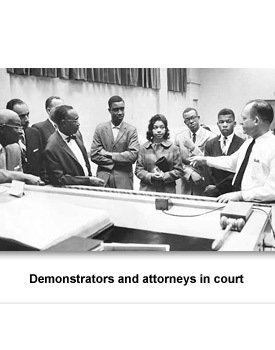
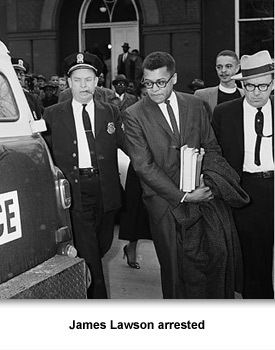
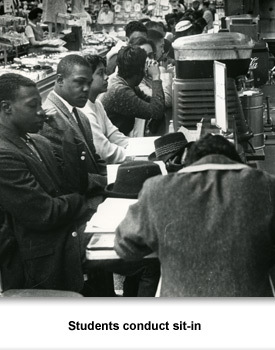
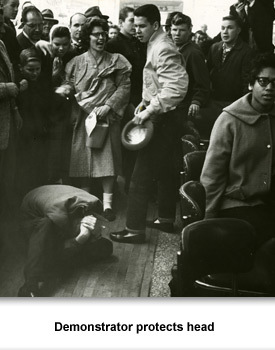
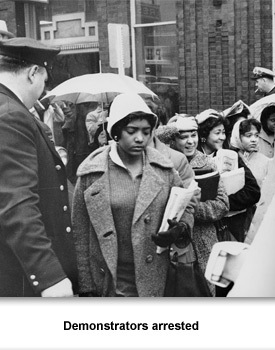
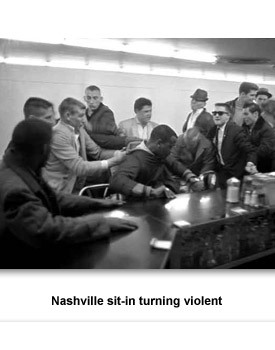
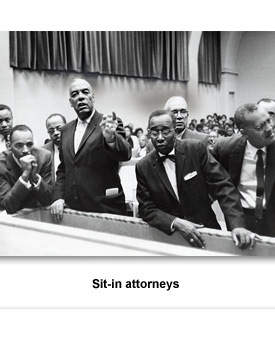
 Sponsored by: National Endowment for the Humanities
Sponsored by: National Endowment for the Humanities